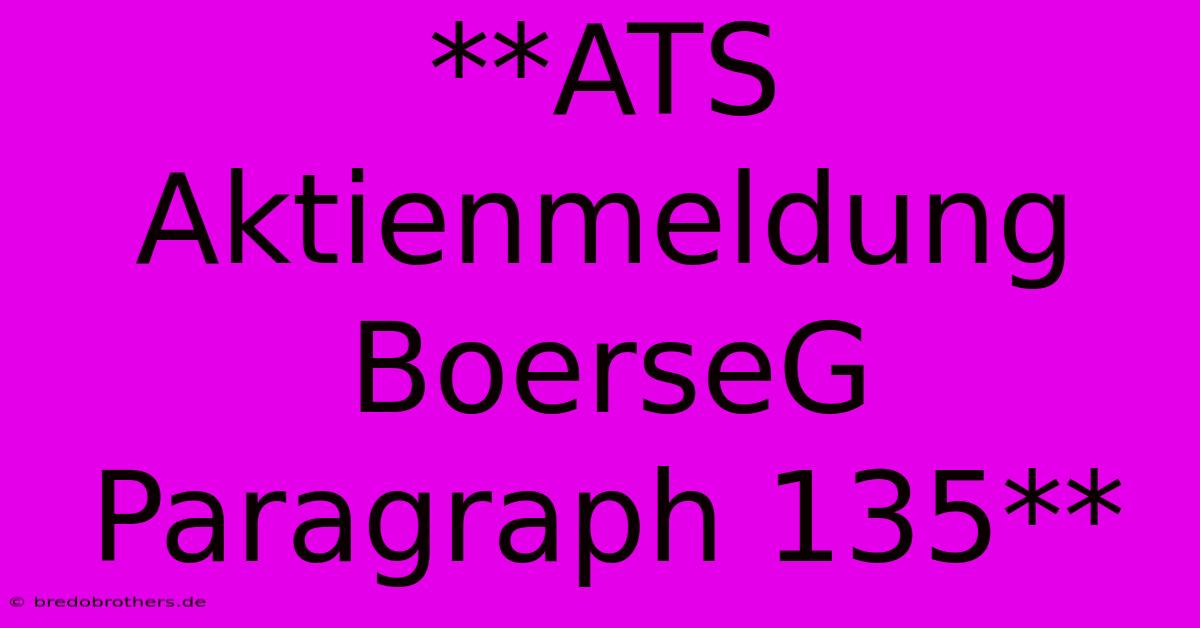**ATS Aktienmeldung BoerseG Paragraph 135**

Discover more detailed and exciting information on our website. Click the link below to start your adventure: Visit Best Website **ATS Aktienmeldung BoerseG Paragraph 135**. Don't miss out!
Table of Contents
Decoding the Mystery: My Battles with ATS Aktienmeldung and BörsenG Paragraph 135
Hey everyone, so, I've been knee-deep in the world of German stock market reporting lately, specifically the dreaded ATS Aktienmeldung and the even more dreaded BörsenG Paragraph 135. Let me tell you, it's been a rollercoaster. Think of it like navigating a minefield blindfolded – and the minefield is made of legal jargon.
I'll be honest, at first, I felt completely lost. I mean, Aktienmeldung? BörsenG? It sounded like some kind of secret code only finance wizards could understand. I was trying to help a friend with their small business, they were dealing with this stuff, and I wanted to understand to help them out. I dove in headfirst, and boy, did I hit a wall. My first attempt at submitting an ATS Aktienmeldung? Epic fail. I missed a crucial deadline and the whole thing was rejected. So frustrating!
My First Big Mistake: Underestimating the Detail
My initial problem? I totally underestimated the level of detail required. I thought, "Oh, it's just a stock market report, how hard can it be?" Spoiler alert: It's hard. Really hard. Paragraph 135 of the BörsenG is incredibly specific about what information needs to be reported and how it should be formatted. Think precise dates, exact figures, and a level of accuracy that would make a tax auditor weep with joy. I missed a few minor details — seemingly insignificant things — and it all came crashing down.
Learning from My Mistakes: Practical Tips for Navigating ATS Aktienmeldungen
So, what did I learn? A whole heck of a lot. And I'm sharing my hard-won wisdom with you guys, to save you the headaches.
- Read Paragraph 135 (multiple times!): Seriously, this is not something you can skim. Download the text, print it out, and highlight key sections. Understand the implications of non-compliance. It’s not a suggestion; it's the law.
- Use the Right Software: Forget trying to do this all manually. There's specialized software designed for creating and submitting ATS Aktienmeldungen. Research this carefully before you start – not all software is created equal. Look for software that guides you through the process step-by-step, ensuring you're hitting all the required fields.
- Double (and Triple) Check Your Data: Accuracy is paramount. Before you hit 'submit', meticulously review every single piece of data. Errors can lead to delays, penalties, and lots of extra work. Think of it as preparing for a final exam that impacts a ton of things.
- Seek Professional Help if Needed: If you’re truly overwhelmed, don’t hesitate to consult a financial expert or lawyer specializing in securities law. It might cost some money, but it could save you a world of trouble.
Understanding the Importance of Timely and Accurate Reporting
Getting this right is crucial, folks. Failing to comply with BörsenG Paragraph 135 and properly file your ATS Aktienmeldung can result in significant penalties. We're talking serious fines. It's not something to take lightly. The consequences, especially for companies listed on the Frankfurt Stock Exchange, for example, can be quite severe. This isn't some small oversight; it's a serious legal matter.
I'm still learning, to be honest. The world of German securities law is a beast. But hopefully, sharing my experience helps some of you avoid the same pitfalls. If you have any questions or tips of your own to share about navigating the ATS Aktienmeldung and BörsenG Paragraph 135 world, let me know in the comments! Let's learn together.

Thank you for visiting our website wich cover about **ATS Aktienmeldung BoerseG Paragraph 135**. We hope the information provided has been useful to you. Feel free to contact us if you have any questions or need further assistance. See you next time and dont miss to bookmark.
Featured Posts
-
Uran Aktien Boom Goldman Sachs Tipp
Nov 28, 2024
-
Monaco Verliert Gegen Benfica Amdouni
Nov 28, 2024
-
Gasmarkt Und Der Preis Von Duenger
Nov 28, 2024
-
Aston Villa Juventus Uebertragung Kostenlos
Nov 28, 2024
-
Ubs Stuft Telekom Auf Neutral Ein
Nov 28, 2024
